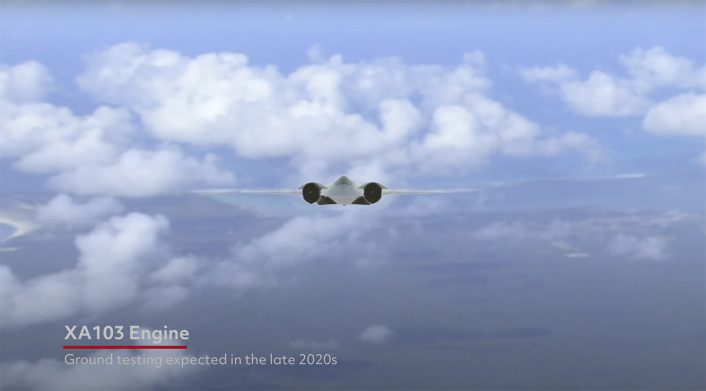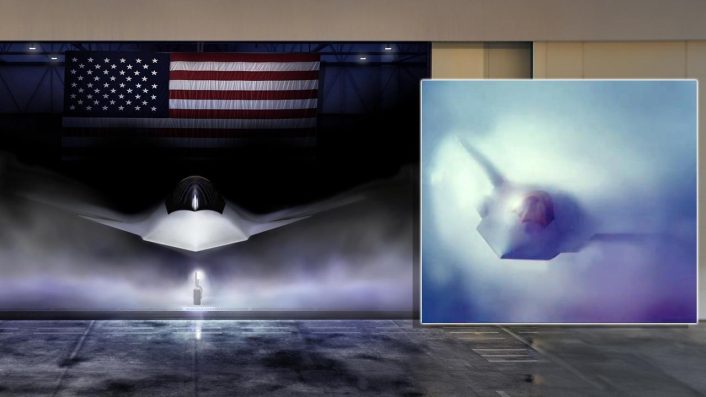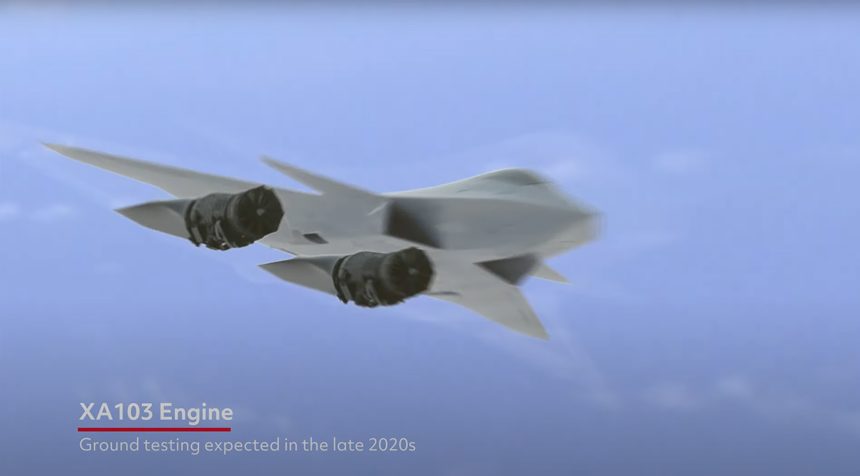Although reminiscent of the official F-47 renderings, the model in RTX’s video is actually based on a notional design by artist Rodrigo Avella.
A new promotional video released by RTX, parent company of engine builder Pratt & Whitney, to support their bid to supply engines for the F-47, shows an interesting new rendering of an unspecified NGAD-style design. However, while some features might be reminiscent of the official F-47 renderings released by the U.S. Air Force, the model in the video is actually based on a notional design by artist Rodrigo Avella.
Pratt & Whitney parent company RTX, formerly known as Raytheon, released a new video depicting computer renderings of their XA103 design via their YouTube channel on Jun. 24, 2025. Along with views of the engine itself, a brief section of the video shows the engines being flown in a computer-generated aircraft design.
The XA103 is an adaptive cycle engine design proposed by Pratt & Whitney for the U.S. Air Force’s next generation fighter aircraft, competing against General Electric’s XA102. Very few exact specifications for these engine designs are presently known, besides the expectation of thrust performance in the 35,000 to 40,000 lbf bracket. These designs both fall under the Next Generation Adaptive Propulsion, or NGAP, program.

The NGAD design
Clearly a stealthy fighter design, the aircraft notably features canards and no vertical stabilizers. While the exact planform of the Boeing F-47, or any other NGAD proposals, is unknown, it has long been thought (and deduced from previous renderings) that these are largely intended to be tailless designs.
However, the model in the video, as mentioned earlier, is based on a notional F/A-XX (the Navy’s own NGAD) design by artist Rodrigo Avella, who first released it in 2017. Avella recently posted again some images of this design on his Instagram profile, mentioning he is aware that his model “was widely used on YouTube and other sites” after the unveiling of the F-47. As a matter of fact, even the Air Force used his models in the past. Anyway, the model includes some different design features compared to the official F-47 rendering, such as the wing dihedral.
Visualizza questo post su Instagram
There has been intense speculation regarding the official renderings released by the U.S. Air Force of the Boeing F-47 which appears to show the aircraft with canard control surfaces. It should be noted, though, that the renderings were reportedly designed and doctored in such a way to obscure the type’s true design features. As such, the featuring of canards in many renderings may be a deliberate attempt at diverting interest towards a completely false design.

That being said, it is more than possible that the F-47, and indeed other NGAD proposals, do feature canards. Though much commentary, particularly with regards to the Chinese J-20, claims that canards are detrimental to an aircraft’s radar cross-section, there are in fact many ways to mitigate any negative effects. Assessments of different aircraft planforms, including canard designs, were made during the development of the Joint Strike Fighter program. The McDonnell Douglas X-36, designed to evaluate the benefits of a tailless fighter design, was notably equipped with canards.
It would be amazingly educational if F-47 has canards.
Some: “canards are not good for stealth”… so, nothing else matters? Not the planform layout? If fixed canards or as control surfaces? The size, angle, material? Always better to flap with the butt?
LM said, eh same, same. https://t.co/ke3fk8biNr pic.twitter.com/WGPZtPzPqW
— Gripen News (@GripenNews) March 22, 2025
New designs emanating from China also show a design choice to forgo vertical stabilizers, with some images showing new trailing edge control surfaces that are likely acting in their place. Notably, though, these new designs do not feature canards.
Also without canards is the Edgewing GCAP, or Tempest, a joint venture between Italy, Japan, and the United Kingdom, and the German-French-Spanish FCAS. Both of these European sixth generation fighter designs do feature traditional tail control surfaces, suggesting an overall less advanced design but one that will likely be a more affordable and smoother evolutionary step from current models.
Next Generation Adaptive Propulsion
As mentioned above, the XA102 and XA103 are the two engines being considered to power the manned NGAD fighter, now known to be the Boeing F-47. Both are adaptive cycle engines using three stream designs that allow the engine’s bypass ratio to be reconfigured in flight for either fuel efficiency and cool-running, or maximum thrust performance and power generation.
Increased power generation is an important consideration given the prospect of directed energy weapons and ever advancing electronic warfare systems that are sure to be integrated onto the F-47. Each company is using their respective XA100 and XA101 engine designs, which were intended as potential options for F-35 re-engining, as the foundations for these new powerplants.

Adaptive cycle engines were previously considered during the Advanced Tactical Fighter (ATF) program that saw the YF-22 and YF-23 compete against each other. Eventually, the more traditional Pratt & Whitney F119 engine was selected to power the winning F-22 fighter.
Critical design reviews were completed for the XA102 and XA103 in 2023 and 2024 respectively, with ground testing then flight testing expected to commence in the coming years. These processes will need to be rapid should the engines be ready for the Boeing F-47’s proposed first flight by 2029.
“Boeing previously built a prototype of the F-47 in secret before 2019. An undisclosed number of additional aircraft will be built to support flight testing during the engineering and manufacturing development phase, with a first flight expected before 2029” ~ Aviation Week pic.twitter.com/pMcBNDIGLn
— AirPower 2.0 (MIL_STD) (@AirPowerNEW1) June 9, 2025
Once the winning design is ready and has matured to a sufficient level, it will be interesting to note whether it will be considered to power future unmanned systems that will operate alongside the F-47. We don’t know for sure how many engines the F-47 will have, although many are expecting a twin-engine design, but smaller and lighter drones could be powered by a single XA102 or XA103 engine.
As the F-47 is designed to work in tandem with unmanned aircraft, termed Collaborative Combat Aircraft (CCA), sharing engine designs between the manned and unmanned segments of a deployable force would be a prudent way to simplify required logistics and maintenance provisions.
Current CCA designs are of a scale where such engines would be vastly overpowered. The YFQ-44A Fury, for example, is expected to utilise a Williams FJ44 powerplant otherwise primarily used by business jets. Future CCAs, though, could grow in size and weight considerably to accommodate greater fuel loads and, more importantly, larger weapon payloads.









